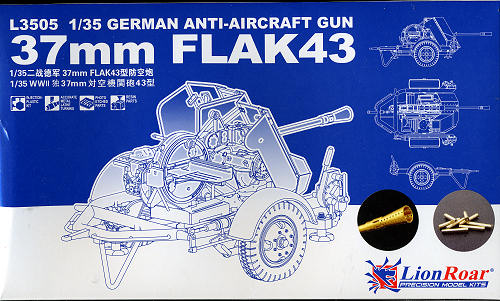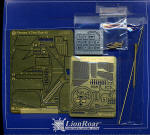
Lion Roar 1/35 37mm FLAK 43
| KIT: | Lion Roar 1/35 37mm FLAK 43 |
| KIT #: | L3505 |
| PRICE: | $ |
| DECALS: | None - Paint masks |
| REVIEWER: | Scott Van Aken |
| NOTES: | Detailed kit with much photoetch. |

| HISTORY |
The original 37 mm gun was developed by Rheinmetall in 1935 as the 3.7 cm Flugzeugabwehrkanone 18. It was essentially an enlarged version of the 2 cm FlaK 30 firing a standard-caliber 37 mm from an L/89 barrel. Like the Flak 30, it used a mechanical bolt for automatic fire, but nevertheless featured a fairly good rate of fire, about 160 RPM (2.7 Hz). The complete gun, including wheeled mount, weighed 1757 kg.
The Flak 18 was produced only in small numbers, and production had already ended in 1936 in favor of well known 2 cm Flakvierling 38, a four-barrel development of the Flak 30. Some development continued, however, resulting in a lighter two-wheel mount produced as the 3.7 Flak 36 that cut the complete weight to 1544 kg. A new sighting system introduced the next year produced the 3.7 Flak 37 that was otherwise similar. It appears existing weapons were brought up to the Flak 37 standard, while new production started in 1942 and produced 1178 before production ended in 1944. The Flak 37 was known as 37 ITK 37 in Finland.
The FLAK 43 -
As Allied air power grew dramatically during the mid-period of the war, the 20 mm quad-mount proved to have too little power and the 37 mm was turned to as its replacement. Not content with the existing versions, Rheinmetall-Borsig and Krupp were asked to produce a new version that was less expensive.
Krupp initially won the contract, but at the last moment the Krupp design developed weaknesses and Rheinmetall-Borsig got the award. This immediately resulted in the factional wrangling in the Nazi party that often beset German wartime industrial production, so by the time Rheinmetall-Borsig was actually able to go ahead well over a year had passed. The design partially able to made up for the delay, however, as it was produced with stampings, welding and simple components in the same way as submachine guns. The production time for a gun was cut by a factor of four.
The new 3.7 Flak 43 was a dramatic improvement over the older models. A new gas-operated breech improved the firing rate to 250 RPM, while at the same time dropping in weight to 1247 kg. It was also produced in a twin-gun mount, the 3.7 cm Flakzwilling 43, although this version was considered somewhat unwieldy and top-heavy.
The Flak 37 could be found in some numbers mounted to the ubiquidous SdKfz 7 or (later) the sWS. The newer Flak 43 was almost always used in a mobile mounting. Most famous of these were the converted Panzer IV's, first the "interim" M÷belwagen, and later the Ostwind, which was considered particularly deadly.
Compared to its closest Allied counterpart, the 40 mm Bofors, the Flak 43 had over double the firing rate, could set up in much smaller spaces, and was considerably lighter when considering the gun and mount together. Luckily for Allied aircrews, this fearsome weapon was put into production far too late to have any real effect on the war effort. Apparently this was due to some political wrangling, and although the weapon was complete in 1942, production did not start until 1944. About 928 single and 185 double versions were produced by end of the war.
| THE KIT |
 Lion Roar has established itself as a superlative photo etch and brass aftermarket company, so I can understand their wanting to get into the high end kit market as well. This is their first FLAK kit as the previous releases have been Nebelwerfers. A good choice as there is a considerable following for guns and the FLAK 43 is something that will look at home in any period diorama.
Lion Roar has established itself as a superlative photo etch and brass aftermarket company, so I can understand their wanting to get into the high end kit market as well. This is their first FLAK kit as the previous releases have been Nebelwerfers. A good choice as there is a considerable following for guns and the FLAK 43 is something that will look at home in any period diorama.
The molding on the three injected sprues is first rate. Careful inspection found only three tiny sink areas, two of them on the sides of the leaf springs. The rest of the parts are very nicely detailed with edges being crisply done, something that you will appreciate. In addition to the three injected sprues, there are two resin wheels. These have separate front hubs to make painting easier, a nice touch.
 Of course, there is a considerable quantity of photo etch and brass with this kit. There are brass shells and an excellent brass barrel. Two pieces of brass wire/tubing are also provided. The wire is to be used when making the various hinges, while the tubing is used to make a couple of the shield supports. Two good sized etched sheets provide the gun shield as well as some of the screen work for the shell cage and a number of other detail parts.
Of course, there is a considerable quantity of photo etch and brass with this kit. There are brass shells and an excellent brass barrel. Two pieces of brass wire/tubing are also provided. The wire is to be used when making the various hinges, while the tubing is used to make a couple of the shield supports. Two good sized etched sheets provide the gun shield as well as some of the screen work for the shell cage and a number of other detail parts.
The kit can be built either in travelling mode or set up to fire. One has to make the decision on which one to build early in the construction process. The instructions are superbly done with well drawn construction steps that show the placement of parts and in the cases of the wire and rod, the size these need to be prior to installation. Color information is provided with Gunze and generic paint references. This is to be painted in overall panzer yellow (RLM 79 tan is called out). While there are no decals, a paint mask with a variety of kill markings is provided.
| CONCLUSIONS |
For fans of anti-aircraft guns or those who just want a highly detailed model that includes everything you need, then this is for you.
| REFERENCES |
http://en.wikipedia.org. May 2008 My thanks to www.dragonmodelsusa.com for the preview kit. Get yours today at your local shop or request them to order you one. If you would like your product reviewed fairly and fairly quickly, please contact the editor or see other details in the Note to Contributors.